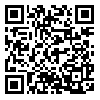Volume 9, Issue 4 (2020)
ORMR 2020, 9(4): 91-115 |
Back to browse issues page
Download citation:
BibTeX | RIS | EndNote | Medlars | ProCite | Reference Manager | RefWorks
Send citation to:



BibTeX | RIS | EndNote | Medlars | ProCite | Reference Manager | RefWorks
Send citation to:
Hamidian M, Hadizadeh Moghadam A, Tabarsa G, Rezaeian A. Presenting a Predictive Model of Employees' Behavior based on Leader-Follower Perceptual Interactions in the ThreatenedSocial Support: Applying Conservation of Resources Approach. ORMR 2020; 9 (4) :91-115
URL: http://ormr.modares.ac.ir/article-28-37047-en.html
URL: http://ormr.modares.ac.ir/article-28-37047-en.html
1- PhD Candidate of Behavioral Management, Faculty of Management and Accounting, Shahid Beheshti University, Tehran, Iran.
2- Associate Prof., Faculty of Management and Accounting, Shahid Beheshti University, Tehran, Iran. ,a-hadizadeh@sbu.ac.ir
3- Professor,Faculty of Management and Accounting, Shahid Beheshti University, Tehran, Iran.
4- Professor, Faculty of Management and Accounting, Shahid Beheshti University, Tehran, Iran.
2- Associate Prof., Faculty of Management and Accounting, Shahid Beheshti University, Tehran, Iran. ,
3- Professor,Faculty of Management and Accounting, Shahid Beheshti University, Tehran, Iran.
4- Professor, Faculty of Management and Accounting, Shahid Beheshti University, Tehran, Iran.
Abstract: (4985 Views)
The main purpose of this study is to predict the behavior of employees according to perception of possible changes in their organizational resources. This research aims to discover the latent behavioral intentions which individuals showing in common, within an organizational ecosystem through an objective approach. Using sequential exploration strategy, the research was implemented through 5 main steps and research model has been verified by means of experimental and empirical methods. The ecosystem studied in this study, was Iranian state and semi-state banks, which were precisely studied in 416 subjects. Also, in order to obtain a model for predicting the organizational behavior of employees, at first, behavioral intentions were typologized by conservation of resources approach, and then modeled with fixed and random effects in form of mixed equations. Results showed that predictions of human behaviors at the ecological level of resources have great commonalities that can be identified by a resource-based approach. The results also showed that the behavioral intentions of employees in Iranian state and semi-state banks in threatenedsocial support is to be passive, andin the presence of positive or negative perceptual interaction from leader, this tendency could change from " being passive” to "trying to retain" in both cases. Identifying the boundary points of changing behavioral intentions and the distance of employees’“behavioral intention" from these points was another finding of this study that could be a guide for regulating effective interventions of leadersin the studied ecosystem.
Article Type: Original Research |
Subject:
Organizational Behavior and Human Resource Management
Received: 2019/10/4 | Accepted: 2020/03/14 | Published: 2020/03/14
Received: 2019/10/4 | Accepted: 2020/03/14 | Published: 2020/03/14
Send email to the article author
| Rights and permissions | |
 |
This work is licensed under a Creative Commons Attribution-NonCommercial 4.0 International License. |







